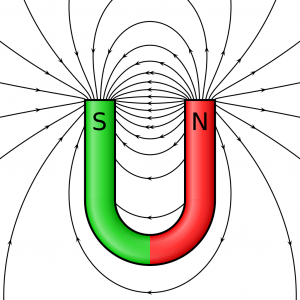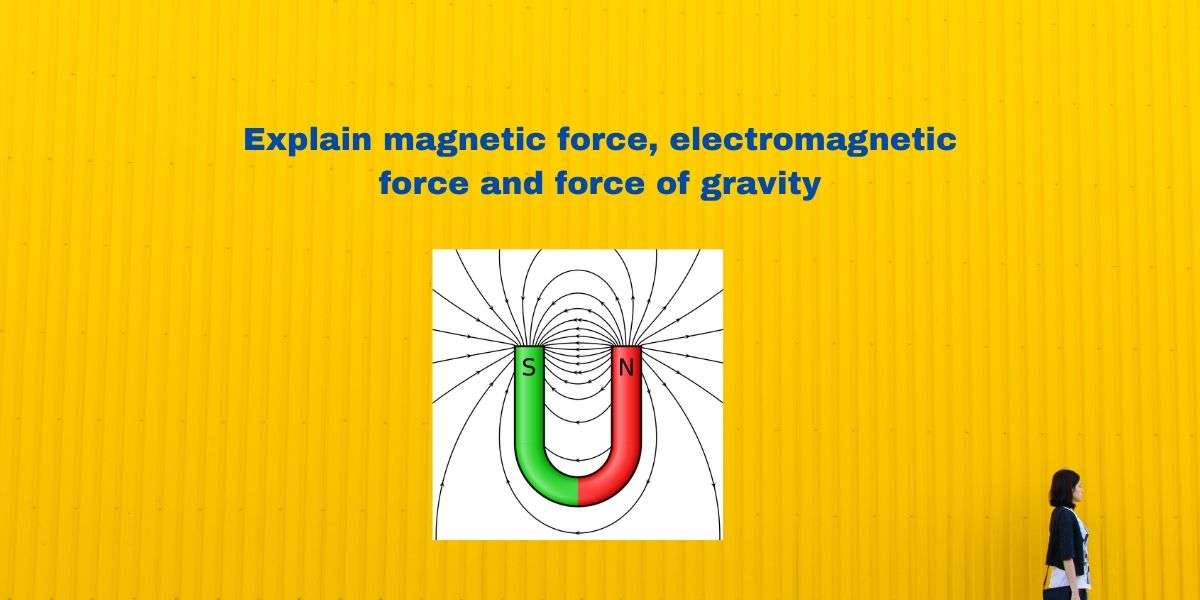Explain magnetic force, electromagnetic force and force of gravity.
What is Electromagnetic Force?
The electromagnetic force is carried by the photon and is responsible for chemical reactions, atomic structure and repulsive forces associated with electrical charge and magnetism. It is a force that occurs between electrically charged particles, such as electrons. The electromagnetic force holds electrons in their orbit around the nucleus.
Electromagnetic induction
The phenomenon of the production of EMF due to a change of magnetic flux linked with a closed circuit is called electromagnetic induction.
Magnetic Force
It is defined as the attractive or repulsive force that is exerted between the poles of a magnet and electrically charged moving particles. It is a consequence of the electromagnetic force, one of the four fundamental forces of nature and is caused by the motion of charges. A magnet is an object which attracts pieces of iron, nickel, steel and copper. Magnetic of electric current is derived by Oersted experiment which concludes that electricity and magnetism are linked with each other.

Oersted’s experiment
In 1820, Hans Christian Oersted, professor of physics at Copenhagen discovered that there exists a relationship between electricity and magnetism. He observed that a compass needle got deflected on passing an electric current through a metallic wire placed horizontally near it. This shows that current-carrying conductor behaves like a bar magnet. This can be explained by the following activity.
- Bar magnet
- Electric effect of moving magnet
- Moving effect of moving charge
Properties of Magnetism
- Magnetism has both magnitude and direction
- It can never intersect with each other
- A tangent at a point gives the direction of the magnetic field at that point.
- Crowded field lines represent a strong field.
- Magnetism formed a continuous closed curve.
Magnet
A magnet is an object which attracts pieces of iron, nickel, steel and copper etc is called a magnet.

Types of magnet
Natural Magnet
The substance which is found in nature and has an attractive property to attract iron and some of its ores is called natural magnets. The natural magnet has an irregular shape. The earth itself acts as a giant natural magnet.
Artificial Magnet
Artificial magnet is generally made from special iron or steel alloys which are usually magnetized electrically. Therefore, the magnet produced from magnetic materials is called an artificial magnet. It can be shaped in any desired size and shape such as U-shape, bar shape and circular shape.
Uses of magnet
- Magnet is used in radio and stereo speakers.
- It is used in refrigerators and other doors, to snap them close.
- It is used in toys.
- Magnet is used in medical therapy.
- Magnetic Resonance Imaging (MRI) uses a magnetic field of powerful magnets to create a picture of organs and structures inside the human body.
- Magnet is used in the production of electricity.
The basic law of Magnetism
- Magnetic poles always exist in pair, i.e. magnetic monopole does not exist.
- Like poles repel each other and unlike poles attracts each other.
- Every magnet attracts a tiny piece of magnetic substance towards it. The end of a bar magnet where the attraction is maximum are called poles of the magnet.
- A freely suspended magnet aligns itself along the north-south direction. The geographic north-seeking end of the magnet is called a north pole. The other end suspended of a magnet that points towards the geographical south is called a south pole.
Magnetic substance and Non-magnetic substance
Magnetic substance: The metallic substances from which magnets can be made are called magnetic substances. Example: Iron, cobalt, nickel, alnico. On the basis of magnetic behaviour, substances can be divided into 3 categories:
- Diamagnetic substances: Diamagnetic substances are such substances when placed in a magnetic field, acquire feeble magnetism opposite to the direction of the magnetic field. Zinc, copper, silver, gold, water etc are the example of diamagnetic substance.
- Paramagnetic substance: Paramagnetic substances are such substances which when placed in a magnetic field acquire feeble magnetism in the direction of the field. Aluminium, sodium, manganese, oxygen etc. are an example of paramagnetic materials.
- Ferromagnetic substance: Ferromagnetic substances are those substances when placed in the magnetic field are strongly magnetized in the direction of the field. Iron, nickel, cobalt etc are the example of a ferromagnetic substance.
Non-magnetic substances: the substances which do not possess magnetic properties are known as non-magnetic substances.
Example: Brass, copper, glass, wood etc.
Force of Gravity
Everybody in the universe attracts every other body with a force called the force of gravitation or force of gravity. The gravity of the force of attraction between the earth and any object lying on or near its surface. Gravitation is the force of attraction between any two objects in the universe.

Gravitation
It is the force of attraction between any two objects. All the objects in the universe attract each other with a certain amount of force, but in most cases, the gravitational force is too weak to be observed due to the very large distance of separation.
Example:
- Rain falls down from the sky to the earth due to the gravitational force of earth or gravity.
- If a ball is thrown upwards, it reaches a certain height and falls downwards because of the gravity of the earth.
Some important facts about Gravitation
- Gravitation is called the 4th law of Newton.
- Gravitational forces are weak and attractive forces.
- Gravitational force is valid for all distances (short and long)
- The value of ‘G’ is determined by Henry Cavendish.
- When two objects are dropped from the same height in a vacuum, they strike at the same time on the surface of the earth irrespective of their masses.
Newton’s law of Gravitation
Newton started that every particle in the universe attracts every other particle with a force that is directly proportional to the product of their masses and inversely proportional to the square of the distance between them.
Consider two bodies of masses m1 and m2 and separated by distance r. According to the law of gravitation, the force of attraction F between them is such that
F ∝ m1 x m2
F ∝ 1/r2
F ∝ m1 x m2/r2
F = G x m1 x m2/r2
Where,
F = gravitational force
m1 = mass of first body
m2 = mass of second body
G = gravitational constant
r = distance between two objects
The Value of G = 6.67 X 10-11 Nm2/kg2
Mass of earth (M) = 6 x 1024 kg
Radius of earth (r) = 6.4 x 106 m
Gravitational constant (G): It is defined as the force of attraction between two bodies of unit mass each and placed a unit distance apart.
- The gravitational constant is denoted by ‘G’.
- Values of G (in SI) = 6.67 x 10-11 Nm2/kg2.
- Value of G (in CGS system) = 6.67 x 10-8 dyn cm2/g2.
- SI unit of G = Nm2/kg2
- CGS unit of G = dyn cm2/g2
Evidence in support of the law of gravitation
- The tides are formed in oceans due to the gravitational force of attraction between the moon and seawater.
- The times of solar and lunar eclipses calculate on the basis of the law of gravitational are found to be reasonably accurate.
- The rotation of the earth around the sun or that of the moon around the earth is explained on the basis of this law.
Important features of Gravitational force
- The law of gravitation strictly holds for point masses.
- The gravitational force is a conservative force.
- The gravitational force between two masses is independent of the intervening medium.
- The gravitational force between two bodies is independent of the presence of other bodies.
- The gravitational force between two point masses is a central force.
Acceleration due to gravity
The acceleration is produced in a freely falling body under the gravitational pull of the earth is called acceleration due to gravity.
- It is denoted by g.
- The value of g on the surface of earth = 9.8 m/s2 or 32 ft/s2.
- It is a vector having directions towards the centre of the earth.
- The value of g at the centre of earth = 0 m/s2.
- The value of g decreases when the object moves upward or downward from the surface of the earth.
- The value of g is maximum at the pole.
- The value of g is minimum at the equator.
- The earth stops to rotate about its own axis, the value of ‘g’ will increase slightly at each point except the pole.
- Value of g on mercury = 3.6 m/s2.
- Value of g on mars = 3.77 m/s2.
- Value of g on Jupiter = 25 m/s2.
- Value of g on moon = 1.63 m/s2.
Freefall: The motion of a body under the influence of gravity alone is called a free fall.
Weight of a body: It is defined as the gravitational force with which a body is attracted towards the centre of the earth.
Some important questions of the above concept
- What is the magnetic force?
- what is Electromagnetic force?
- Define Magnet.
- Difference between the magnetic material and non-magnetic material.
- what is gravity?
- Define free fall.
I hope you like this post-What is Electromagnetic force, magnetic force and gravity.
